Business Research Project: Cosmetics & Customer Perception
VerifiedAdded on 2020/06/04
|11
|890
|616
Project
AI Summary
This document presents a business research project proposal examining customers' perceptions of environment-friendly and ethical cosmetic products and their influence on purchasing decisions. The study focuses on the cosmetic industry's shift towards natural ingredients and ethical practices, particularly highlighting companies like Beauty Without Cruelty. The introduction outlines the background, rationale, aim, and objectives, which include evaluating customer perceptions, analyzing operational practices, comparing cost principles, and examining the impact of ethical factors. The methodology section details the research approach, type, strategy, data collection methods, sampling, and data analysis techniques. The proposal also includes a time scale, risk factors, and ethical research requirements. The research aims to answer key questions such as customers' willingness to pay more for eco-friendly cosmetics and the influence of ethical practices on purchase decisions. The proposal provides a comprehensive framework for investigating customer behavior and the cosmetic industry's evolution towards sustainability and ethical considerations.
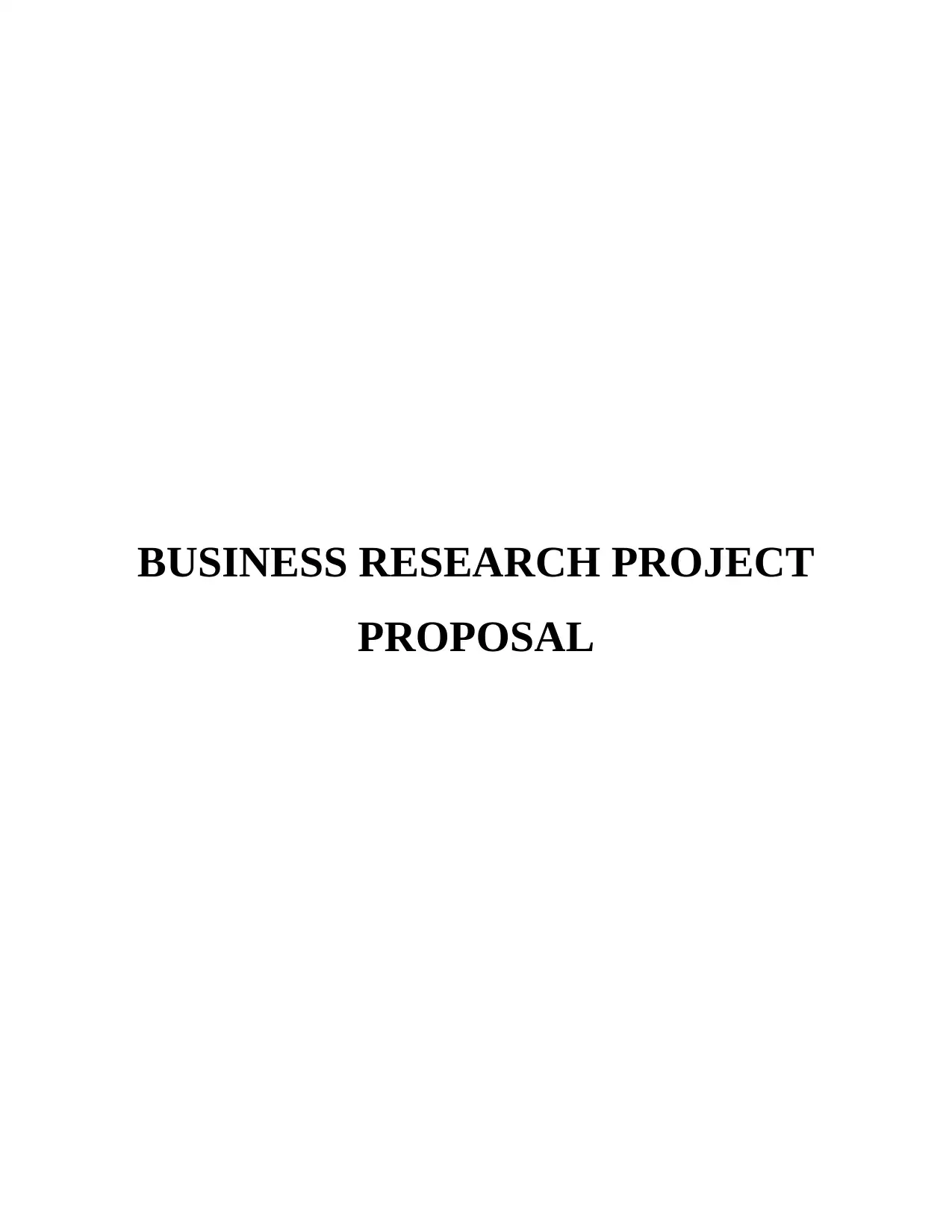
BUSINESS RESEARCH PROJECT
PROPOSAL
PROPOSAL
Paraphrase This Document
Need a fresh take? Get an instant paraphrase of this document with our AI Paraphraser
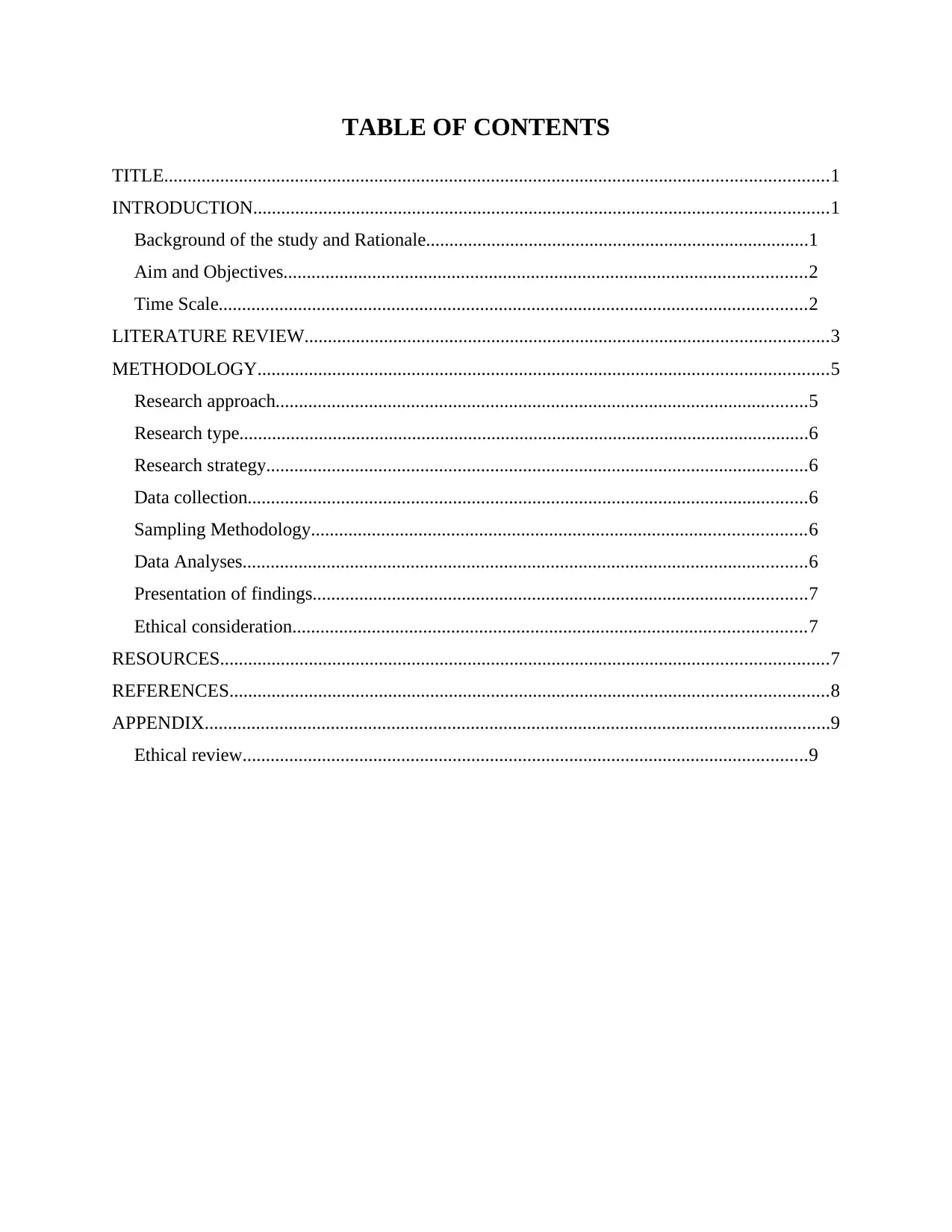
TABLE OF CONTENTS
TITLE..............................................................................................................................................1
INTRODUCTION...........................................................................................................................1
Background of the study and Rationale..................................................................................1
Aim and Objectives................................................................................................................2
Time Scale..............................................................................................................................2
LITERATURE REVIEW................................................................................................................3
METHODOLOGY..........................................................................................................................5
Research approach..................................................................................................................5
Research type..........................................................................................................................6
Research strategy....................................................................................................................6
Data collection........................................................................................................................6
Sampling Methodology..........................................................................................................6
Data Analyses.........................................................................................................................6
Presentation of findings..........................................................................................................7
Ethical consideration..............................................................................................................7
RESOURCES..................................................................................................................................7
REFERENCES................................................................................................................................8
APPENDIX......................................................................................................................................9
Ethical review.........................................................................................................................9
TITLE..............................................................................................................................................1
INTRODUCTION...........................................................................................................................1
Background of the study and Rationale..................................................................................1
Aim and Objectives................................................................................................................2
Time Scale..............................................................................................................................2
LITERATURE REVIEW................................................................................................................3
METHODOLOGY..........................................................................................................................5
Research approach..................................................................................................................5
Research type..........................................................................................................................6
Research strategy....................................................................................................................6
Data collection........................................................................................................................6
Sampling Methodology..........................................................................................................6
Data Analyses.........................................................................................................................6
Presentation of findings..........................................................................................................7
Ethical consideration..............................................................................................................7
RESOURCES..................................................................................................................................7
REFERENCES................................................................................................................................8
APPENDIX......................................................................................................................................9
Ethical review.........................................................................................................................9
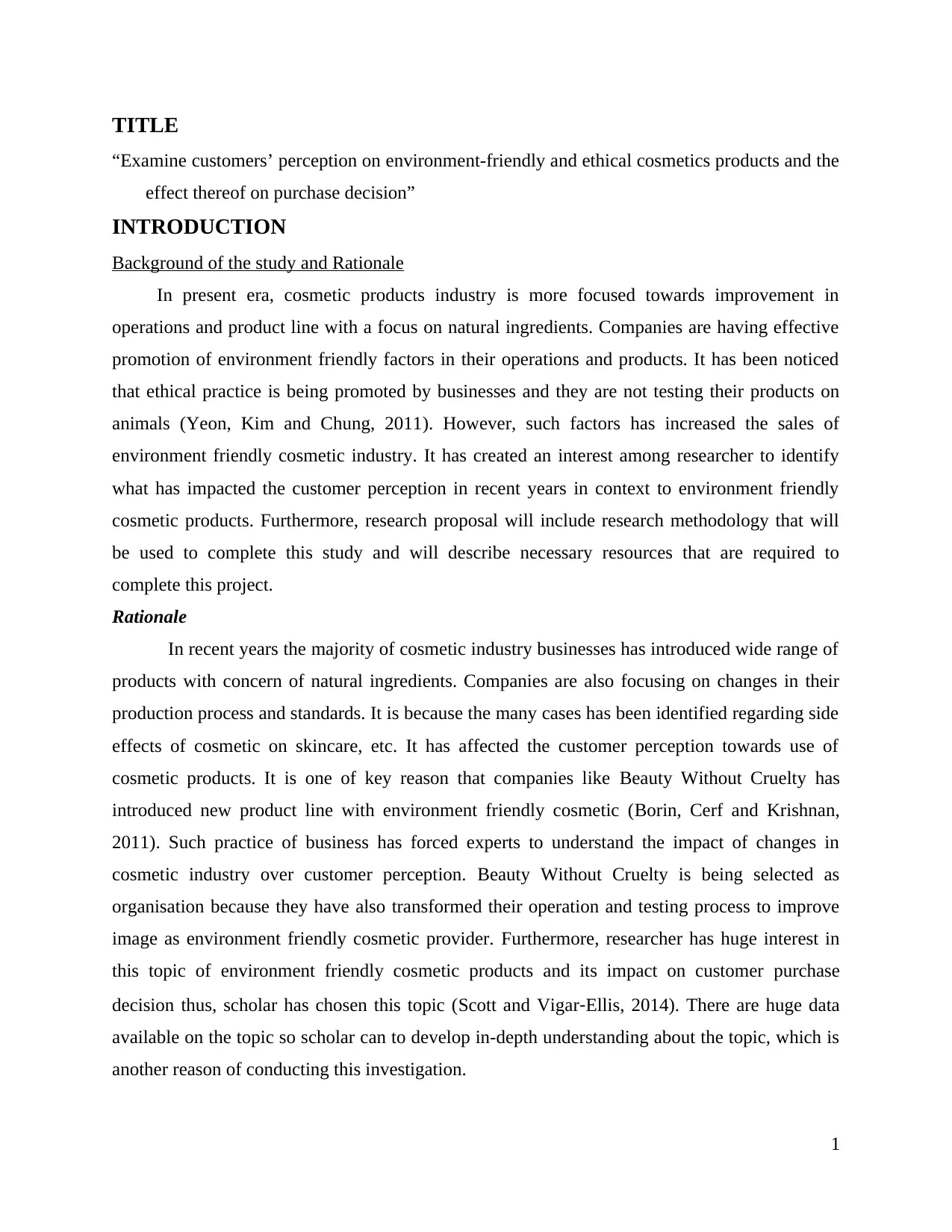
TITLE
“Examine customers’ perception on environment-friendly and ethical cosmetics products and the
effect thereof on purchase decision”
INTRODUCTION
Background of the study and Rationale
In present era, cosmetic products industry is more focused towards improvement in
operations and product line with a focus on natural ingredients. Companies are having effective
promotion of environment friendly factors in their operations and products. It has been noticed
that ethical practice is being promoted by businesses and they are not testing their products on
animals (Yeon, Kim and Chung, 2011). However, such factors has increased the sales of
environment friendly cosmetic industry. It has created an interest among researcher to identify
what has impacted the customer perception in recent years in context to environment friendly
cosmetic products. Furthermore, research proposal will include research methodology that will
be used to complete this study and will describe necessary resources that are required to
complete this project.
Rationale
In recent years the majority of cosmetic industry businesses has introduced wide range of
products with concern of natural ingredients. Companies are also focusing on changes in their
production process and standards. It is because the many cases has been identified regarding side
effects of cosmetic on skincare, etc. It has affected the customer perception towards use of
cosmetic products. It is one of key reason that companies like Beauty Without Cruelty has
introduced new product line with environment friendly cosmetic (Borin, Cerf and Krishnan,
2011). Such practice of business has forced experts to understand the impact of changes in
cosmetic industry over customer perception. Beauty Without Cruelty is being selected as
organisation because they have also transformed their operation and testing process to improve
image as environment friendly cosmetic provider. Furthermore, researcher has huge interest in
this topic of environment friendly cosmetic products and its impact on customer purchase
decision thus, scholar has chosen this topic (Scott and Vigar‐Ellis, 2014). There are huge data
available on the topic so scholar can to develop in-depth understanding about the topic, which is
another reason of conducting this investigation.
1
“Examine customers’ perception on environment-friendly and ethical cosmetics products and the
effect thereof on purchase decision”
INTRODUCTION
Background of the study and Rationale
In present era, cosmetic products industry is more focused towards improvement in
operations and product line with a focus on natural ingredients. Companies are having effective
promotion of environment friendly factors in their operations and products. It has been noticed
that ethical practice is being promoted by businesses and they are not testing their products on
animals (Yeon, Kim and Chung, 2011). However, such factors has increased the sales of
environment friendly cosmetic industry. It has created an interest among researcher to identify
what has impacted the customer perception in recent years in context to environment friendly
cosmetic products. Furthermore, research proposal will include research methodology that will
be used to complete this study and will describe necessary resources that are required to
complete this project.
Rationale
In recent years the majority of cosmetic industry businesses has introduced wide range of
products with concern of natural ingredients. Companies are also focusing on changes in their
production process and standards. It is because the many cases has been identified regarding side
effects of cosmetic on skincare, etc. It has affected the customer perception towards use of
cosmetic products. It is one of key reason that companies like Beauty Without Cruelty has
introduced new product line with environment friendly cosmetic (Borin, Cerf and Krishnan,
2011). Such practice of business has forced experts to understand the impact of changes in
cosmetic industry over customer perception. Beauty Without Cruelty is being selected as
organisation because they have also transformed their operation and testing process to improve
image as environment friendly cosmetic provider. Furthermore, researcher has huge interest in
this topic of environment friendly cosmetic products and its impact on customer purchase
decision thus, scholar has chosen this topic (Scott and Vigar‐Ellis, 2014). There are huge data
available on the topic so scholar can to develop in-depth understanding about the topic, which is
another reason of conducting this investigation.
1
⊘ This is a preview!⊘
Do you want full access?
Subscribe today to unlock all pages.

Trusted by 1+ million students worldwide
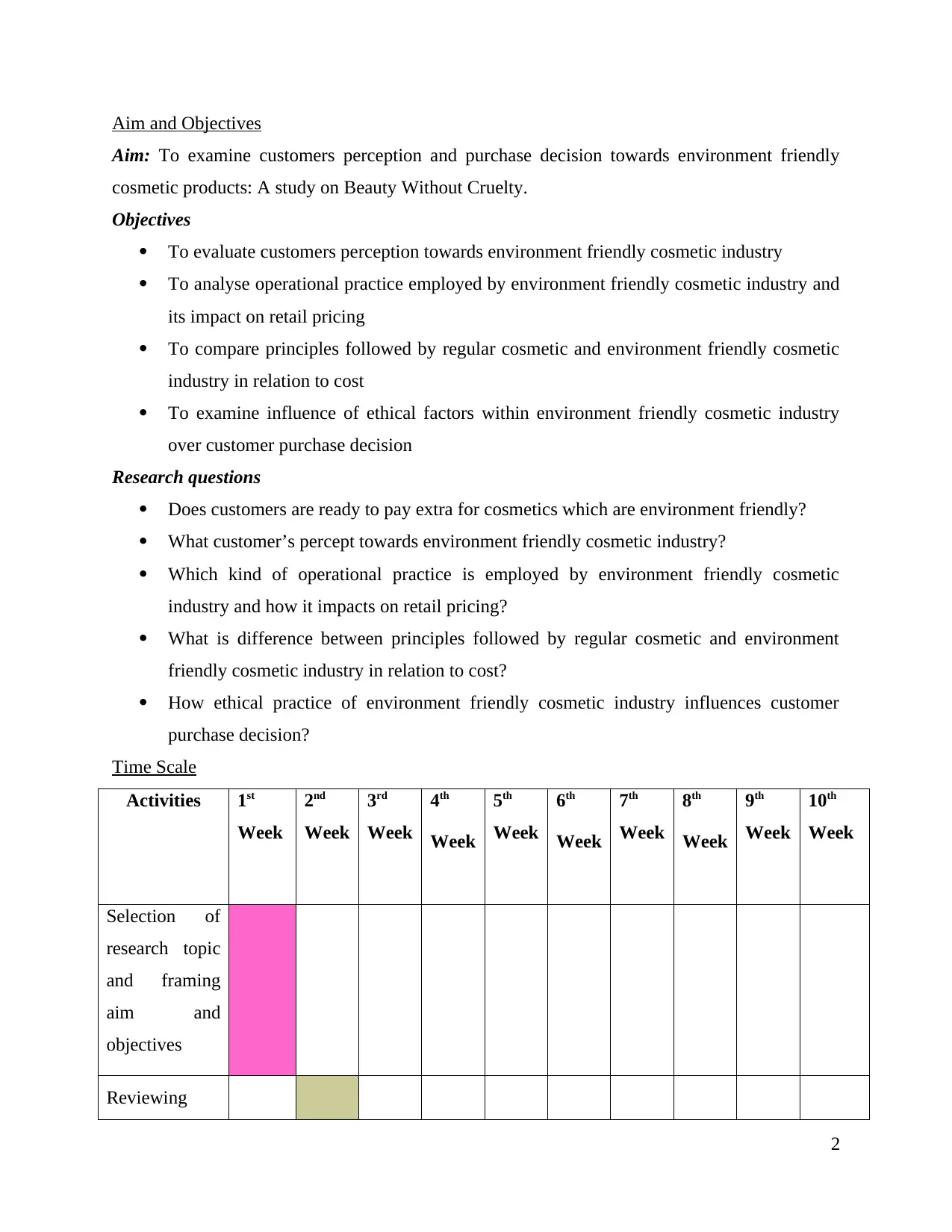
Aim and Objectives
Aim: To examine customers perception and purchase decision towards environment friendly
cosmetic products: A study on Beauty Without Cruelty.
Objectives
To evaluate customers perception towards environment friendly cosmetic industry
To analyse operational practice employed by environment friendly cosmetic industry and
its impact on retail pricing
To compare principles followed by regular cosmetic and environment friendly cosmetic
industry in relation to cost
To examine influence of ethical factors within environment friendly cosmetic industry
over customer purchase decision
Research questions
Does customers are ready to pay extra for cosmetics which are environment friendly?
What customer’s percept towards environment friendly cosmetic industry?
Which kind of operational practice is employed by environment friendly cosmetic
industry and how it impacts on retail pricing?
What is difference between principles followed by regular cosmetic and environment
friendly cosmetic industry in relation to cost?
How ethical practice of environment friendly cosmetic industry influences customer
purchase decision?
Time Scale
Activities 1st
Week
2nd
Week
3rd
Week
4th
Week
5th
Week
6th
Week
7th
Week
8th
Week
9th
Week
10th
Week
Selection of
research topic
and framing
aim and
objectives
Reviewing
2
Aim: To examine customers perception and purchase decision towards environment friendly
cosmetic products: A study on Beauty Without Cruelty.
Objectives
To evaluate customers perception towards environment friendly cosmetic industry
To analyse operational practice employed by environment friendly cosmetic industry and
its impact on retail pricing
To compare principles followed by regular cosmetic and environment friendly cosmetic
industry in relation to cost
To examine influence of ethical factors within environment friendly cosmetic industry
over customer purchase decision
Research questions
Does customers are ready to pay extra for cosmetics which are environment friendly?
What customer’s percept towards environment friendly cosmetic industry?
Which kind of operational practice is employed by environment friendly cosmetic
industry and how it impacts on retail pricing?
What is difference between principles followed by regular cosmetic and environment
friendly cosmetic industry in relation to cost?
How ethical practice of environment friendly cosmetic industry influences customer
purchase decision?
Time Scale
Activities 1st
Week
2nd
Week
3rd
Week
4th
Week
5th
Week
6th
Week
7th
Week
8th
Week
9th
Week
10th
Week
Selection of
research topic
and framing
aim and
objectives
Reviewing
2
Paraphrase This Document
Need a fresh take? Get an instant paraphrase of this document with our AI Paraphraser
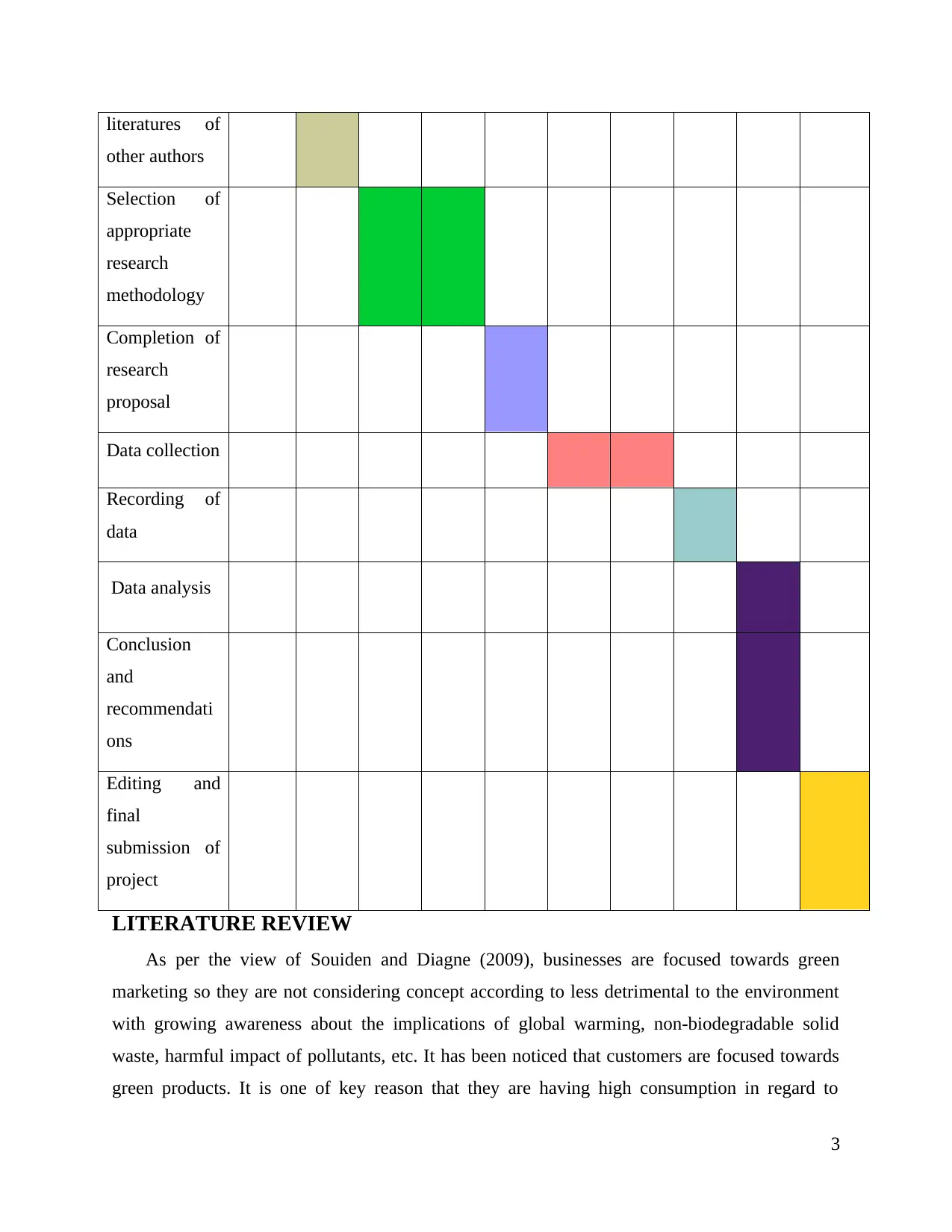
literatures of
other authors
Selection of
appropriate
research
methodology
Completion of
research
proposal
Data collection
Recording of
data
Data analysis
Conclusion
and
recommendati
ons
Editing and
final
submission of
project
LITERATURE REVIEW
As per the view of Souiden and Diagne (2009), businesses are focused towards green
marketing so they are not considering concept according to less detrimental to the environment
with growing awareness about the implications of global warming, non-biodegradable solid
waste, harmful impact of pollutants, etc. It has been noticed that customers are focused towards
green products. It is one of key reason that they are having high consumption in regard to
3
other authors
Selection of
appropriate
research
methodology
Completion of
research
proposal
Data collection
Recording of
data
Data analysis
Conclusion
and
recommendati
ons
Editing and
final
submission of
project
LITERATURE REVIEW
As per the view of Souiden and Diagne (2009), businesses are focused towards green
marketing so they are not considering concept according to less detrimental to the environment
with growing awareness about the implications of global warming, non-biodegradable solid
waste, harmful impact of pollutants, etc. It has been noticed that customers are focused towards
green products. It is one of key reason that they are having high consumption in regard to
3
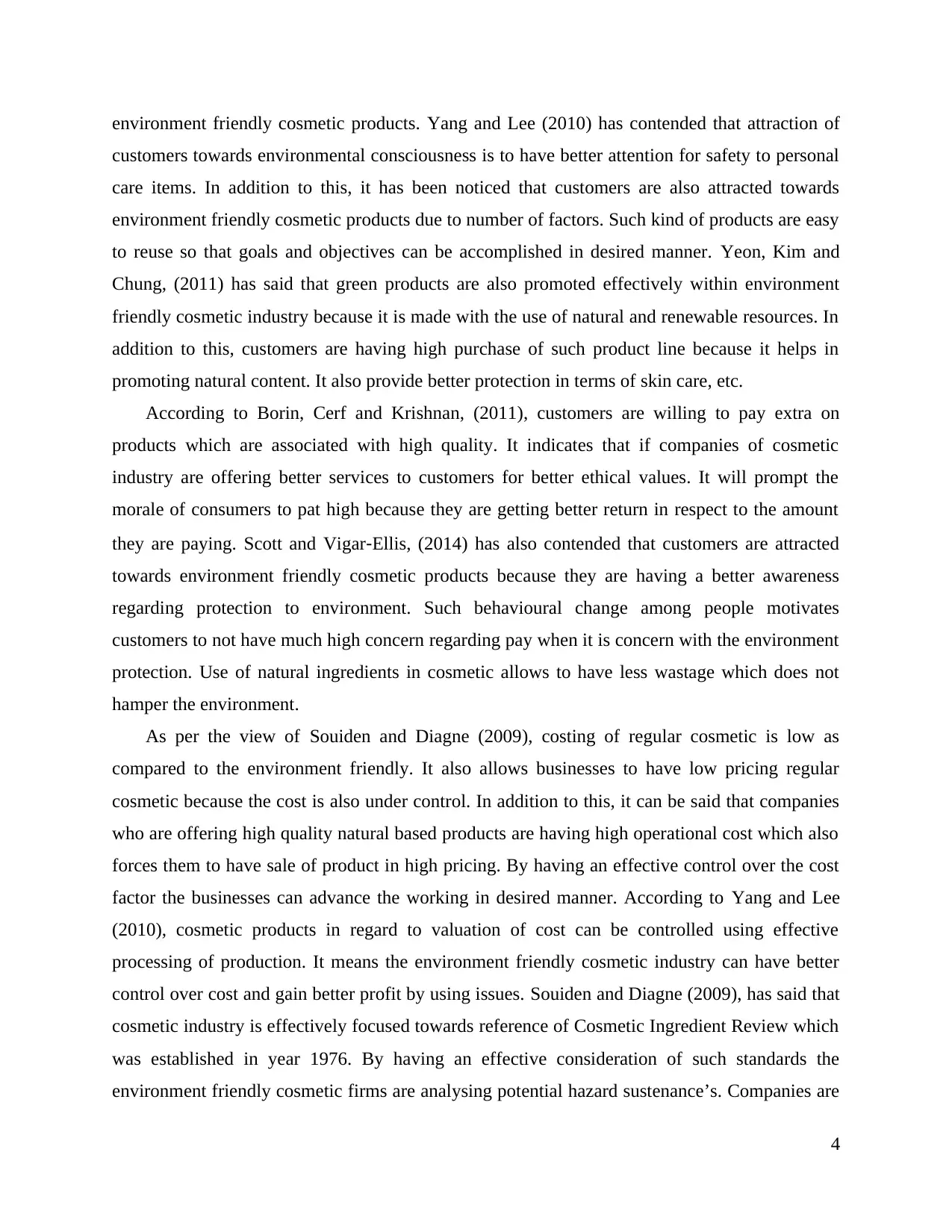
environment friendly cosmetic products. Yang and Lee (2010) has contended that attraction of
customers towards environmental consciousness is to have better attention for safety to personal
care items. In addition to this, it has been noticed that customers are also attracted towards
environment friendly cosmetic products due to number of factors. Such kind of products are easy
to reuse so that goals and objectives can be accomplished in desired manner. Yeon, Kim and
Chung, (2011) has said that green products are also promoted effectively within environment
friendly cosmetic industry because it is made with the use of natural and renewable resources. In
addition to this, customers are having high purchase of such product line because it helps in
promoting natural content. It also provide better protection in terms of skin care, etc.
According to Borin, Cerf and Krishnan, (2011), customers are willing to pay extra on
products which are associated with high quality. It indicates that if companies of cosmetic
industry are offering better services to customers for better ethical values. It will prompt the
morale of consumers to pat high because they are getting better return in respect to the amount
they are paying. Scott and Vigar‐Ellis, (2014) has also contended that customers are attracted
towards environment friendly cosmetic products because they are having a better awareness
regarding protection to environment. Such behavioural change among people motivates
customers to not have much high concern regarding pay when it is concern with the environment
protection. Use of natural ingredients in cosmetic allows to have less wastage which does not
hamper the environment.
As per the view of Souiden and Diagne (2009), costing of regular cosmetic is low as
compared to the environment friendly. It also allows businesses to have low pricing regular
cosmetic because the cost is also under control. In addition to this, it can be said that companies
who are offering high quality natural based products are having high operational cost which also
forces them to have sale of product in high pricing. By having an effective control over the cost
factor the businesses can advance the working in desired manner. According to Yang and Lee
(2010), cosmetic products in regard to valuation of cost can be controlled using effective
processing of production. It means the environment friendly cosmetic industry can have better
control over cost and gain better profit by using issues. Souiden and Diagne (2009), has said that
cosmetic industry is effectively focused towards reference of Cosmetic Ingredient Review which
was established in year 1976. By having an effective consideration of such standards the
environment friendly cosmetic firms are analysing potential hazard sustenance’s. Companies are
4
customers towards environmental consciousness is to have better attention for safety to personal
care items. In addition to this, it has been noticed that customers are also attracted towards
environment friendly cosmetic products due to number of factors. Such kind of products are easy
to reuse so that goals and objectives can be accomplished in desired manner. Yeon, Kim and
Chung, (2011) has said that green products are also promoted effectively within environment
friendly cosmetic industry because it is made with the use of natural and renewable resources. In
addition to this, customers are having high purchase of such product line because it helps in
promoting natural content. It also provide better protection in terms of skin care, etc.
According to Borin, Cerf and Krishnan, (2011), customers are willing to pay extra on
products which are associated with high quality. It indicates that if companies of cosmetic
industry are offering better services to customers for better ethical values. It will prompt the
morale of consumers to pat high because they are getting better return in respect to the amount
they are paying. Scott and Vigar‐Ellis, (2014) has also contended that customers are attracted
towards environment friendly cosmetic products because they are having a better awareness
regarding protection to environment. Such behavioural change among people motivates
customers to not have much high concern regarding pay when it is concern with the environment
protection. Use of natural ingredients in cosmetic allows to have less wastage which does not
hamper the environment.
As per the view of Souiden and Diagne (2009), costing of regular cosmetic is low as
compared to the environment friendly. It also allows businesses to have low pricing regular
cosmetic because the cost is also under control. In addition to this, it can be said that companies
who are offering high quality natural based products are having high operational cost which also
forces them to have sale of product in high pricing. By having an effective control over the cost
factor the businesses can advance the working in desired manner. According to Yang and Lee
(2010), cosmetic products in regard to valuation of cost can be controlled using effective
processing of production. It means the environment friendly cosmetic industry can have better
control over cost and gain better profit by using issues. Souiden and Diagne (2009), has said that
cosmetic industry is effectively focused towards reference of Cosmetic Ingredient Review which
was established in year 1976. By having an effective consideration of such standards the
environment friendly cosmetic firms are analysing potential hazard sustenance’s. Companies are
4
⊘ This is a preview!⊘
Do you want full access?
Subscribe today to unlock all pages.

Trusted by 1+ million students worldwide
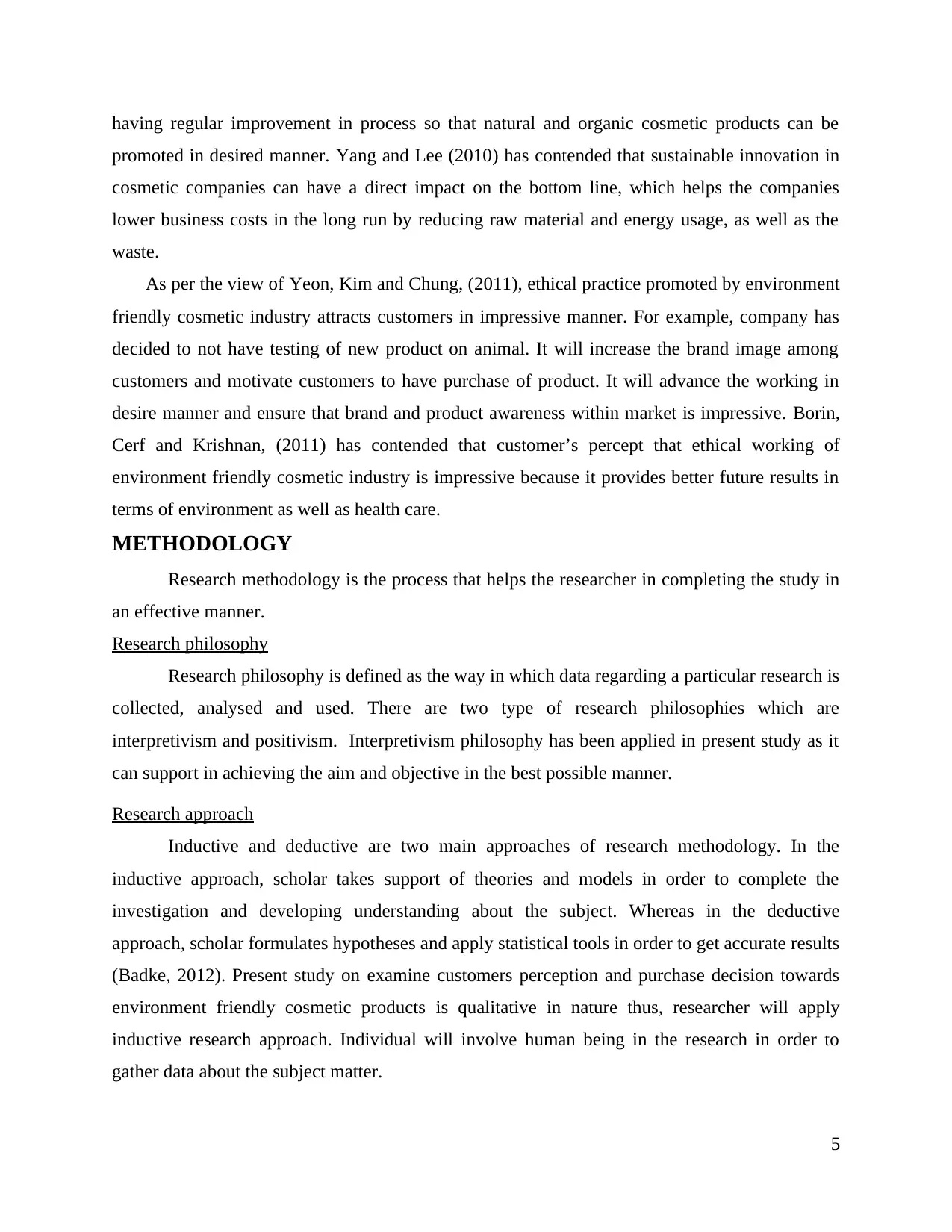
having regular improvement in process so that natural and organic cosmetic products can be
promoted in desired manner. Yang and Lee (2010) has contended that sustainable innovation in
cosmetic companies can have a direct impact on the bottom line, which helps the companies
lower business costs in the long run by reducing raw material and energy usage, as well as the
waste.
As per the view of Yeon, Kim and Chung, (2011), ethical practice promoted by environment
friendly cosmetic industry attracts customers in impressive manner. For example, company has
decided to not have testing of new product on animal. It will increase the brand image among
customers and motivate customers to have purchase of product. It will advance the working in
desire manner and ensure that brand and product awareness within market is impressive. Borin,
Cerf and Krishnan, (2011) has contended that customer’s percept that ethical working of
environment friendly cosmetic industry is impressive because it provides better future results in
terms of environment as well as health care.
METHODOLOGY
Research methodology is the process that helps the researcher in completing the study in
an effective manner.
Research philosophy
Research philosophy is defined as the way in which data regarding a particular research is
collected, analysed and used. There are two type of research philosophies which are
interpretivism and positivism. Interpretivism philosophy has been applied in present study as it
can support in achieving the aim and objective in the best possible manner.
Research approach
Inductive and deductive are two main approaches of research methodology. In the
inductive approach, scholar takes support of theories and models in order to complete the
investigation and developing understanding about the subject. Whereas in the deductive
approach, scholar formulates hypotheses and apply statistical tools in order to get accurate results
(Badke, 2012). Present study on examine customers perception and purchase decision towards
environment friendly cosmetic products is qualitative in nature thus, researcher will apply
inductive research approach. Individual will involve human being in the research in order to
gather data about the subject matter.
5
promoted in desired manner. Yang and Lee (2010) has contended that sustainable innovation in
cosmetic companies can have a direct impact on the bottom line, which helps the companies
lower business costs in the long run by reducing raw material and energy usage, as well as the
waste.
As per the view of Yeon, Kim and Chung, (2011), ethical practice promoted by environment
friendly cosmetic industry attracts customers in impressive manner. For example, company has
decided to not have testing of new product on animal. It will increase the brand image among
customers and motivate customers to have purchase of product. It will advance the working in
desire manner and ensure that brand and product awareness within market is impressive. Borin,
Cerf and Krishnan, (2011) has contended that customer’s percept that ethical working of
environment friendly cosmetic industry is impressive because it provides better future results in
terms of environment as well as health care.
METHODOLOGY
Research methodology is the process that helps the researcher in completing the study in
an effective manner.
Research philosophy
Research philosophy is defined as the way in which data regarding a particular research is
collected, analysed and used. There are two type of research philosophies which are
interpretivism and positivism. Interpretivism philosophy has been applied in present study as it
can support in achieving the aim and objective in the best possible manner.
Research approach
Inductive and deductive are two main approaches of research methodology. In the
inductive approach, scholar takes support of theories and models in order to complete the
investigation and developing understanding about the subject. Whereas in the deductive
approach, scholar formulates hypotheses and apply statistical tools in order to get accurate results
(Badke, 2012). Present study on examine customers perception and purchase decision towards
environment friendly cosmetic products is qualitative in nature thus, researcher will apply
inductive research approach. Individual will involve human being in the research in order to
gather data about the subject matter.
5
Paraphrase This Document
Need a fresh take? Get an instant paraphrase of this document with our AI Paraphraser
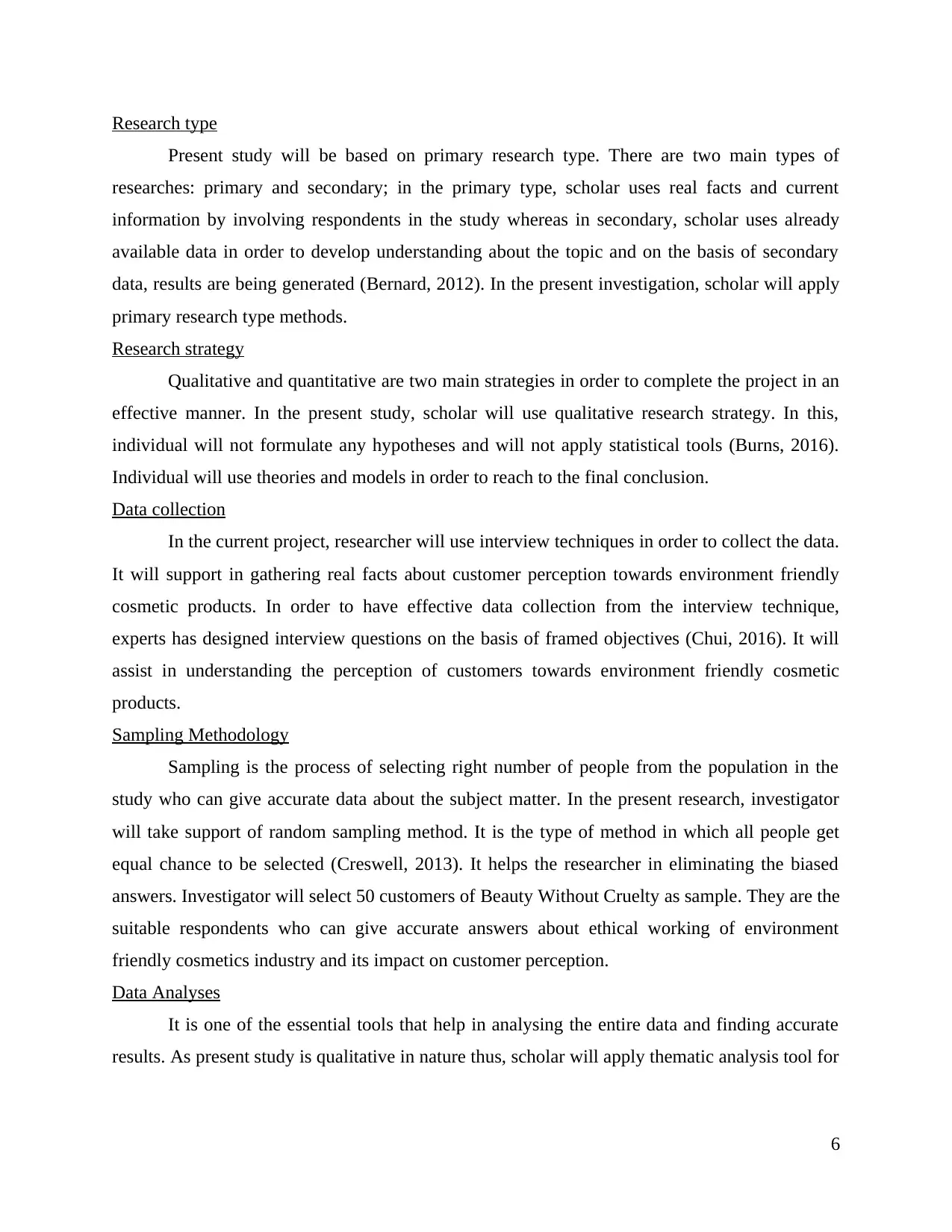
Research type
Present study will be based on primary research type. There are two main types of
researches: primary and secondary; in the primary type, scholar uses real facts and current
information by involving respondents in the study whereas in secondary, scholar uses already
available data in order to develop understanding about the topic and on the basis of secondary
data, results are being generated (Bernard, 2012). In the present investigation, scholar will apply
primary research type methods.
Research strategy
Qualitative and quantitative are two main strategies in order to complete the project in an
effective manner. In the present study, scholar will use qualitative research strategy. In this,
individual will not formulate any hypotheses and will not apply statistical tools (Burns, 2016).
Individual will use theories and models in order to reach to the final conclusion.
Data collection
In the current project, researcher will use interview techniques in order to collect the data.
It will support in gathering real facts about customer perception towards environment friendly
cosmetic products. In order to have effective data collection from the interview technique,
experts has designed interview questions on the basis of framed objectives (Chui, 2016). It will
assist in understanding the perception of customers towards environment friendly cosmetic
products.
Sampling Methodology
Sampling is the process of selecting right number of people from the population in the
study who can give accurate data about the subject matter. In the present research, investigator
will take support of random sampling method. It is the type of method in which all people get
equal chance to be selected (Creswell, 2013). It helps the researcher in eliminating the biased
answers. Investigator will select 50 customers of Beauty Without Cruelty as sample. They are the
suitable respondents who can give accurate answers about ethical working of environment
friendly cosmetics industry and its impact on customer perception.
Data Analyses
It is one of the essential tools that help in analysing the entire data and finding accurate
results. As present study is qualitative in nature thus, scholar will apply thematic analysis tool for
6
Present study will be based on primary research type. There are two main types of
researches: primary and secondary; in the primary type, scholar uses real facts and current
information by involving respondents in the study whereas in secondary, scholar uses already
available data in order to develop understanding about the topic and on the basis of secondary
data, results are being generated (Bernard, 2012). In the present investigation, scholar will apply
primary research type methods.
Research strategy
Qualitative and quantitative are two main strategies in order to complete the project in an
effective manner. In the present study, scholar will use qualitative research strategy. In this,
individual will not formulate any hypotheses and will not apply statistical tools (Burns, 2016).
Individual will use theories and models in order to reach to the final conclusion.
Data collection
In the current project, researcher will use interview techniques in order to collect the data.
It will support in gathering real facts about customer perception towards environment friendly
cosmetic products. In order to have effective data collection from the interview technique,
experts has designed interview questions on the basis of framed objectives (Chui, 2016). It will
assist in understanding the perception of customers towards environment friendly cosmetic
products.
Sampling Methodology
Sampling is the process of selecting right number of people from the population in the
study who can give accurate data about the subject matter. In the present research, investigator
will take support of random sampling method. It is the type of method in which all people get
equal chance to be selected (Creswell, 2013). It helps the researcher in eliminating the biased
answers. Investigator will select 50 customers of Beauty Without Cruelty as sample. They are the
suitable respondents who can give accurate answers about ethical working of environment
friendly cosmetics industry and its impact on customer perception.
Data Analyses
It is one of the essential tools that help in analysing the entire data and finding accurate
results. As present study is qualitative in nature thus, scholar will apply thematic analysis tool for
6
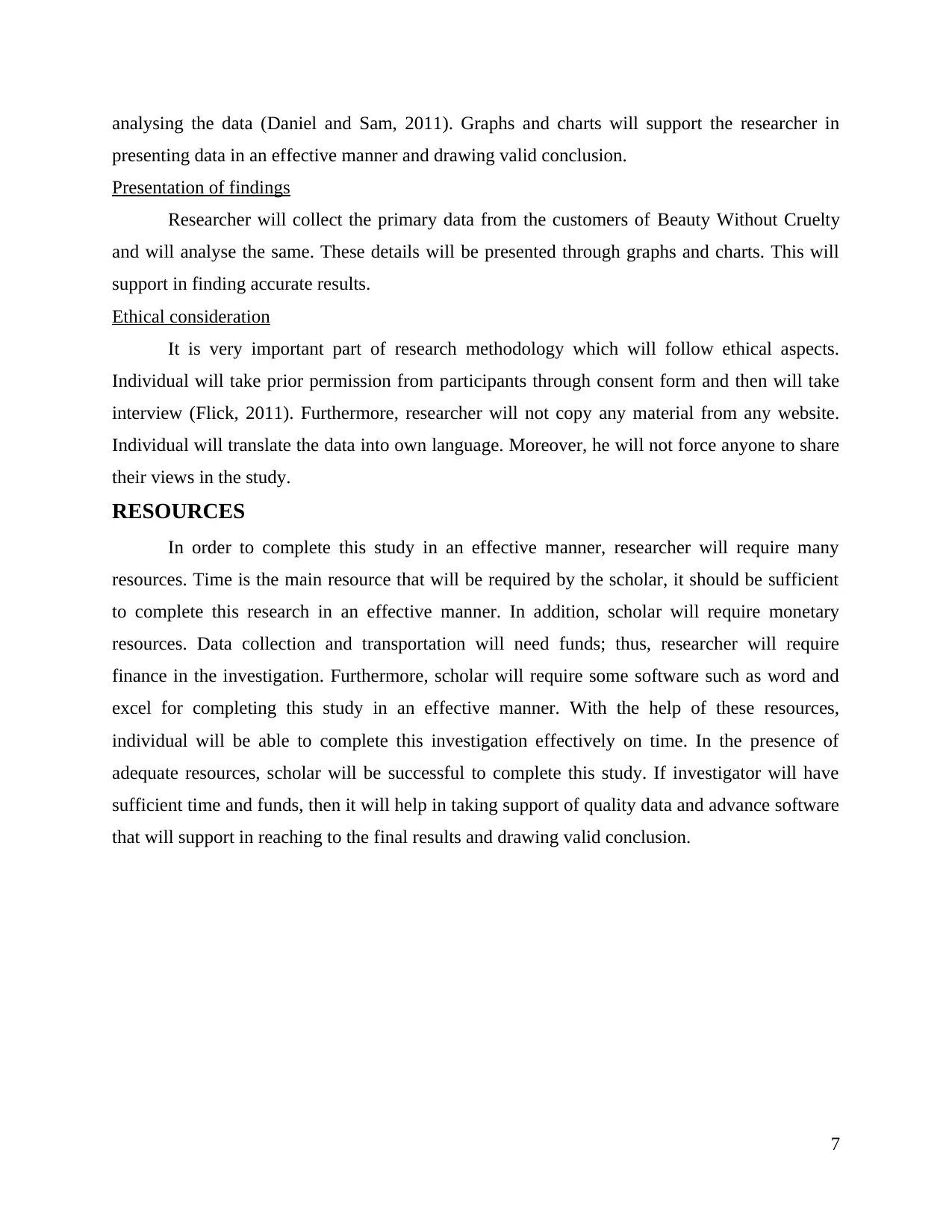
analysing the data (Daniel and Sam, 2011). Graphs and charts will support the researcher in
presenting data in an effective manner and drawing valid conclusion.
Presentation of findings
Researcher will collect the primary data from the customers of Beauty Without Cruelty
and will analyse the same. These details will be presented through graphs and charts. This will
support in finding accurate results.
Ethical consideration
It is very important part of research methodology which will follow ethical aspects.
Individual will take prior permission from participants through consent form and then will take
interview (Flick, 2011). Furthermore, researcher will not copy any material from any website.
Individual will translate the data into own language. Moreover, he will not force anyone to share
their views in the study.
RESOURCES
In order to complete this study in an effective manner, researcher will require many
resources. Time is the main resource that will be required by the scholar, it should be sufficient
to complete this research in an effective manner. In addition, scholar will require monetary
resources. Data collection and transportation will need funds; thus, researcher will require
finance in the investigation. Furthermore, scholar will require some software such as word and
excel for completing this study in an effective manner. With the help of these resources,
individual will be able to complete this investigation effectively on time. In the presence of
adequate resources, scholar will be successful to complete this study. If investigator will have
sufficient time and funds, then it will help in taking support of quality data and advance software
that will support in reaching to the final results and drawing valid conclusion.
7
presenting data in an effective manner and drawing valid conclusion.
Presentation of findings
Researcher will collect the primary data from the customers of Beauty Without Cruelty
and will analyse the same. These details will be presented through graphs and charts. This will
support in finding accurate results.
Ethical consideration
It is very important part of research methodology which will follow ethical aspects.
Individual will take prior permission from participants through consent form and then will take
interview (Flick, 2011). Furthermore, researcher will not copy any material from any website.
Individual will translate the data into own language. Moreover, he will not force anyone to share
their views in the study.
RESOURCES
In order to complete this study in an effective manner, researcher will require many
resources. Time is the main resource that will be required by the scholar, it should be sufficient
to complete this research in an effective manner. In addition, scholar will require monetary
resources. Data collection and transportation will need funds; thus, researcher will require
finance in the investigation. Furthermore, scholar will require some software such as word and
excel for completing this study in an effective manner. With the help of these resources,
individual will be able to complete this investigation effectively on time. In the presence of
adequate resources, scholar will be successful to complete this study. If investigator will have
sufficient time and funds, then it will help in taking support of quality data and advance software
that will support in reaching to the final results and drawing valid conclusion.
7
⊘ This is a preview!⊘
Do you want full access?
Subscribe today to unlock all pages.

Trusted by 1+ million students worldwide
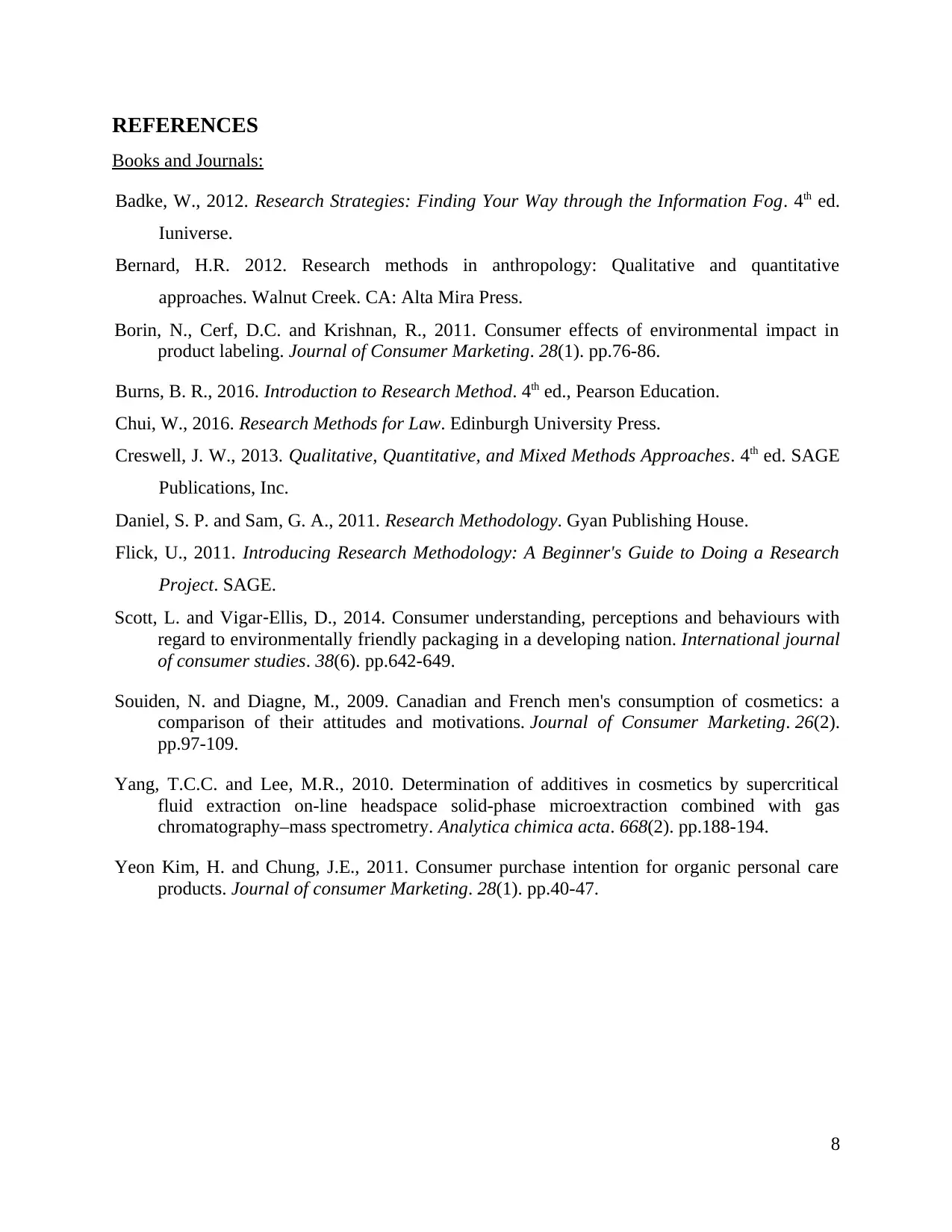
REFERENCES
Books and Journals:
Badke, W., 2012. Research Strategies: Finding Your Way through the Information Fog. 4th ed.
Iuniverse.
Bernard, H.R. 2012. Research methods in anthropology: Qualitative and quantitative
approaches. Walnut Creek. CA: Alta Mira Press.
Borin, N., Cerf, D.C. and Krishnan, R., 2011. Consumer effects of environmental impact in
product labeling. Journal of Consumer Marketing. 28(1). pp.76-86.
Burns, B. R., 2016. Introduction to Research Method. 4th ed., Pearson Education.
Chui, W., 2016. Research Methods for Law. Edinburgh University Press.
Creswell, J. W., 2013. Qualitative, Quantitative, and Mixed Methods Approaches. 4th ed. SAGE
Publications, Inc.
Daniel, S. P. and Sam, G. A., 2011. Research Methodology. Gyan Publishing House.
Flick, U., 2011. Introducing Research Methodology: A Beginner's Guide to Doing a Research
Project. SAGE.
Scott, L. and Vigar‐Ellis, D., 2014. Consumer understanding, perceptions and behaviours with
regard to environmentally friendly packaging in a developing nation. International journal
of consumer studies. 38(6). pp.642-649.
Souiden, N. and Diagne, M., 2009. Canadian and French men's consumption of cosmetics: a
comparison of their attitudes and motivations. Journal of Consumer Marketing. 26(2).
pp.97-109.
Yang, T.C.C. and Lee, M.R., 2010. Determination of additives in cosmetics by supercritical
fluid extraction on-line headspace solid-phase microextraction combined with gas
chromatography–mass spectrometry. Analytica chimica acta. 668(2). pp.188-194.
Yeon Kim, H. and Chung, J.E., 2011. Consumer purchase intention for organic personal care
products. Journal of consumer Marketing. 28(1). pp.40-47.
8
Books and Journals:
Badke, W., 2012. Research Strategies: Finding Your Way through the Information Fog. 4th ed.
Iuniverse.
Bernard, H.R. 2012. Research methods in anthropology: Qualitative and quantitative
approaches. Walnut Creek. CA: Alta Mira Press.
Borin, N., Cerf, D.C. and Krishnan, R., 2011. Consumer effects of environmental impact in
product labeling. Journal of Consumer Marketing. 28(1). pp.76-86.
Burns, B. R., 2016. Introduction to Research Method. 4th ed., Pearson Education.
Chui, W., 2016. Research Methods for Law. Edinburgh University Press.
Creswell, J. W., 2013. Qualitative, Quantitative, and Mixed Methods Approaches. 4th ed. SAGE
Publications, Inc.
Daniel, S. P. and Sam, G. A., 2011. Research Methodology. Gyan Publishing House.
Flick, U., 2011. Introducing Research Methodology: A Beginner's Guide to Doing a Research
Project. SAGE.
Scott, L. and Vigar‐Ellis, D., 2014. Consumer understanding, perceptions and behaviours with
regard to environmentally friendly packaging in a developing nation. International journal
of consumer studies. 38(6). pp.642-649.
Souiden, N. and Diagne, M., 2009. Canadian and French men's consumption of cosmetics: a
comparison of their attitudes and motivations. Journal of Consumer Marketing. 26(2).
pp.97-109.
Yang, T.C.C. and Lee, M.R., 2010. Determination of additives in cosmetics by supercritical
fluid extraction on-line headspace solid-phase microextraction combined with gas
chromatography–mass spectrometry. Analytica chimica acta. 668(2). pp.188-194.
Yeon Kim, H. and Chung, J.E., 2011. Consumer purchase intention for organic personal care
products. Journal of consumer Marketing. 28(1). pp.40-47.
8
Paraphrase This Document
Need a fresh take? Get an instant paraphrase of this document with our AI Paraphraser
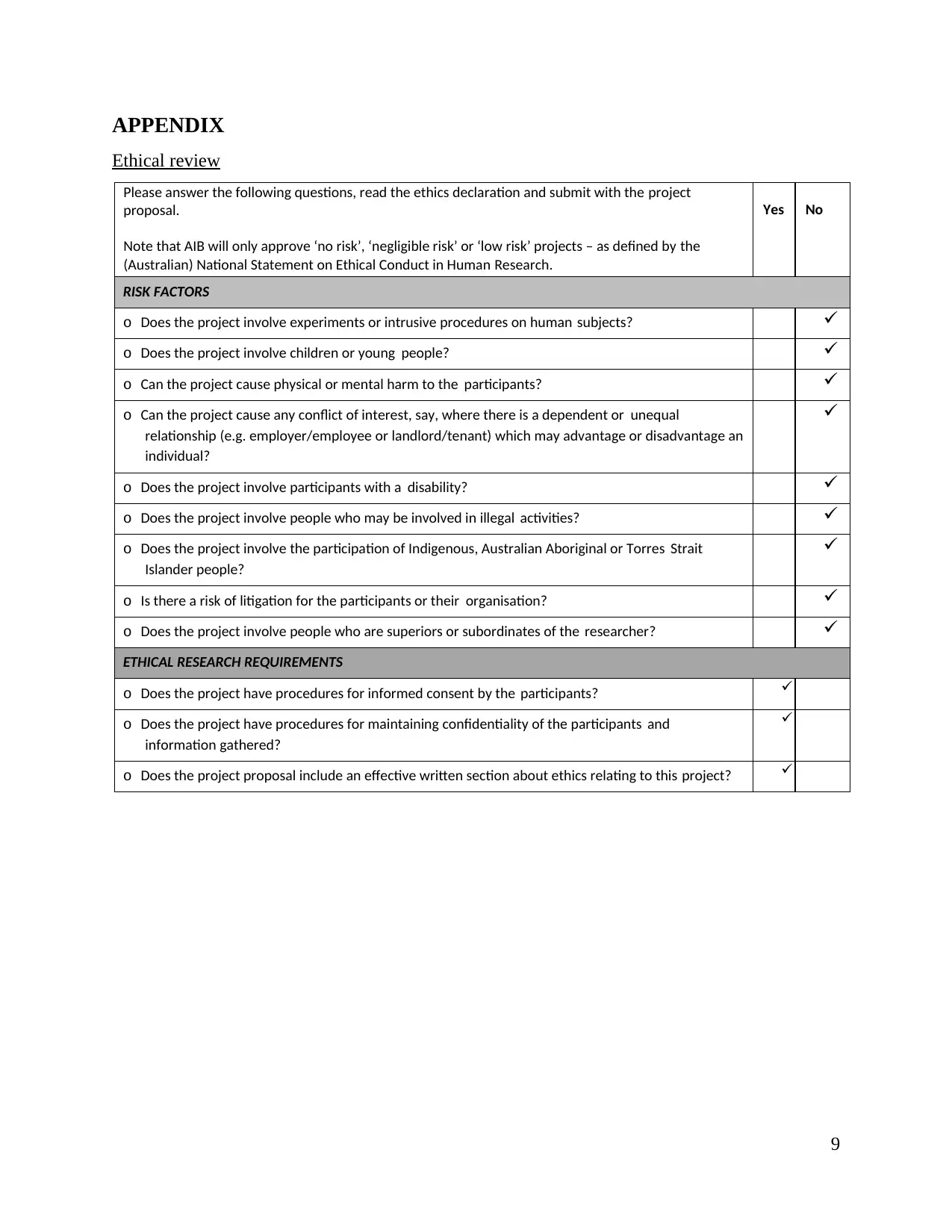
APPENDIX
Ethical review
Please answer the following questions, read the ethics declaration and submit with the project
proposal.
Note that AIB will only approve ‘no risk’, ‘negligible risk’ or ‘low risk’ projects – as defined by the
(Australian) National Statement on Ethical Conduct in Human Research.
Yes No
RISK FACTORS
o Does the project involve experiments or intrusive procedures on human subjects?
o Does the project involve children or young people?
o Can the project cause physical or mental harm to the participants?
o Can the project cause any conflict of interest, say, where there is a dependent or unequal
relationship (e.g. employer/employee or landlord/tenant) which may advantage or disadvantage an
individual?
o Does the project involve participants with a disability?
o Does the project involve people who may be involved in illegal activities?
o Does the project involve the participation of Indigenous, Australian Aboriginal or Torres Strait
Islander people?
o Is there a risk of litigation for the participants or their organisation?
o Does the project involve people who are superiors or subordinates of the researcher?
ETHICAL RESEARCH REQUIREMENTS
o Does the project have procedures for informed consent by the participants?
o Does the project have procedures for maintaining confidentiality of the participants and
information gathered?
o Does the project proposal include an effective written section about ethics relating to this project?
9
Ethical review
Please answer the following questions, read the ethics declaration and submit with the project
proposal.
Note that AIB will only approve ‘no risk’, ‘negligible risk’ or ‘low risk’ projects – as defined by the
(Australian) National Statement on Ethical Conduct in Human Research.
Yes No
RISK FACTORS
o Does the project involve experiments or intrusive procedures on human subjects?
o Does the project involve children or young people?
o Can the project cause physical or mental harm to the participants?
o Can the project cause any conflict of interest, say, where there is a dependent or unequal
relationship (e.g. employer/employee or landlord/tenant) which may advantage or disadvantage an
individual?
o Does the project involve participants with a disability?
o Does the project involve people who may be involved in illegal activities?
o Does the project involve the participation of Indigenous, Australian Aboriginal or Torres Strait
Islander people?
o Is there a risk of litigation for the participants or their organisation?
o Does the project involve people who are superiors or subordinates of the researcher?
ETHICAL RESEARCH REQUIREMENTS
o Does the project have procedures for informed consent by the participants?
o Does the project have procedures for maintaining confidentiality of the participants and
information gathered?
o Does the project proposal include an effective written section about ethics relating to this project?
9
1 out of 11
Related Documents
Your All-in-One AI-Powered Toolkit for Academic Success.
+13062052269
info@desklib.com
Available 24*7 on WhatsApp / Email
![[object Object]](/_next/static/media/star-bottom.7253800d.svg)
Unlock your academic potential
Copyright © 2020–2025 A2Z Services. All Rights Reserved. Developed and managed by ZUCOL.





